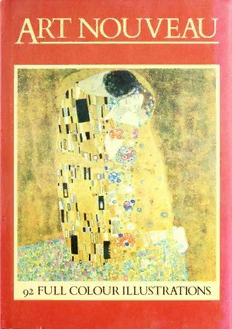
Art Nouveau The Style of the 1890s PDF
Preview Art Nouveau The Style of the 1890s
RT NOUVEi^ laiv 'JO n.P I 1 r.'Jl • FULL COLOUR ILLUSTRATIONS 92 ART NOUVEAU THE STYLE OF THE 1890s ART NOUVEAU THE STYLE OF THE 1890s General Editor Francesco Abbate Translated by Elizabeth Evans PEERAGE BOOKS English edition first publishedby Octopus Books This edition published by Peerage Books 59 GrosvenorStreet London Wl Translation © 1972 Octopus Books Originally published in Italian by Gruppo Editoriale Fabbri S.p.A. © 1966 Gruppo Editoriale Fabbri S.p.A.. Milan ISBN 907408 14 1 Printed in Italy by Gruppo Editoriale Fabbri S.p.A. CONTENTS The Art Nouveau period 7 Bibliography 154 List of Illustrations 155 THE ART NOUVEAU PERIOD The turn of the nineteenth century was a complex period of intense activities, so rich in innovations in every field that it must be regarded as one ofthe most decisive eras in the history of European civilization. For society was then changing in many fundamental ways as technical progress, the growth ofindustry and new economic factors created notjust new problems, but also a new type of society. The aristocracy had lost much of its power and the bourgeoisie, after a period of great wealth and prosperity, was now threatened by moral and financial crises; in contrast the masses were growing increasingly self-aware, in- spired by a new revolutionary mood. The turn of the century was markedby the first political disturbances, the first strikes, the first claims for human rights, all ofwhich were inspired and infiamed by anarchical and socialist theories spreading rapidly through the countries of Europe. It was in this period of ferment and pressing demand for change, in an atmosphere of polemics, decadence and new ideals that some of the basic premiises of modern art were first uttered. The cultural scene shows a wide variety of conflicting reactions to these influences, which ob\iously reflect the very complexity of the situation. For this was a period of extraordinary contrasts embracing both the flnal glories of the Belle Epoque and the explosion of new social demands and pressures, a continuance of old traditions and the statement of new ideals, the intimity of Marcel Proust and the more popular theories behind Art Xouveau. And so, too, the most talented and interesting personalities of the age were continually in contact with a wide variety of fresh ideas and attitudes. In Pans, for example the circle of people connected with the Revue Blanche represented a new type of intellectual elite, holding left-wing and anarchical opinions yet - and here lay the paradox — they were highly sophisticated people, indeed their leader was one of the most fascinating and sought- after men in Pans. If this should not seem unusual today, it was certainly not the case in the 1890s. Several of the great masters of Impressionism were still active at this period and around the turn of the centur\", their creative talent undiminished. Renoir, after a period spent renewing his acquaintance with classical traditions, was now living in southern France. There he devoted himself with redoubled vigour to painting bright open-air landscapes in which the light and heat ofthe sun are made to caress and enhance natural forms. Monet was dedicated to capturing the infinitely subtle variations in the ap- pearance of things produced by shifts of atmosphere and the changing times of day. He had gradually limited the range of his optical experiments while at 1 Paul Serusier 1863-1927j : Meditation, c 1890. Prrcate Collection, Paris.
